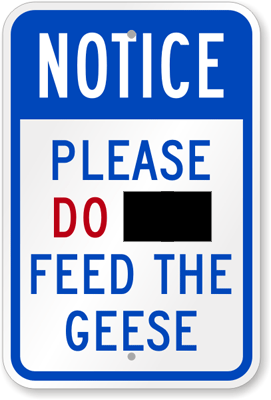
Should We Develop or Replace Sellers?
I’m sure we’ve all heard the Aesop Fable about the goose and the golden egg, yes? One version goes something like this: A farmer had a goose that laid a golden egg each day. The farmer got greedy, however, and tried squeezing the goose so it would lay two eggs each day...
The farmer squeezed the goose so hard looking for that second golden egg that he killed the goose. It’s a story of shortsighted greed. If we overlay this fable onto the world of sales, however, the moral shifts one of greed to one of culture.
Unless they’re in a retrenchment mode or some other less common situation, most businesses are seeking top-line growth. Our goose fable analogy addresses those companies seeking higher revenues through its sales force (there are other ways to generate revenue, after all). It’s a pretty straightforward analogy; the geese are the sellers, and the revenue generated by each seller is the golden egg. However, unlike the fable, in a competitive business environment growth isn’t greedy, it’s a necessity; companies can’t be satisfied with a given number of geese producing a given number of golden eggs or they’ll find themselves being taken to task by their competition. What are the options, then, for increasing the number of golden eggs?
Option 1: Squeeze the goose
This is probably the most common approach, if for no other reason than it’s the way most sales leaders were “incentivized” when they were once sellers themselves. This potentially draconian approach also follows the rhythm of the market’s reporting cycle; as the months, quarters, and fiscal years draw to close, the pressure to meet financial goals increases – so, the geese get squeezed. Another name for this might be the carrot and stick approach: carrots, such as SPIFFs and other monetary tools, perhaps even a sales leader who puts their Dr. Henry Jekyll face on at the beginning of a reporting period; and sticks which come out at the end of reporting periods, such as threats, ultimatums, and sales leaders who shift to their Mr. Edward Hyde face. Pipeline calls start sounding more like verbal firing squads and Spanish Inquisitions. Depending upon the personality of the goose, it either shuts down egg production all together or manages to lay a second golden egg, either by coercing (if not pleading with) their clients to buy early (which, if the client is smart, will do so only in exchange for something to their advantage), by cutting price until profit is seriously eroded or, at worst, the goose does something unethical to lay another egg just to make the squeezing stop.
Does it work?
Yes and no. Yes, it does, in the short term, otherwise it wouldn’t be among the most common tales of woe we hear from sellers. Deals do get closed. The success of this approach, however, is in large part a function of just how bad a Mr. Hyde the sales leader can be. Don’t confuse this with the usual pressure a sales leader is expected to place on their sellers from day to day; here, we’re talking about the end-game behavior of trying to make up for not having done one’s job properly for the previous six to twelve months and attempting to correct it in a matter of two weeks or less. Crash diets don’t fix the underlying cause for being obese, and squeezing the goose isn’t going to address the core problems in a sales organization.
The reasons it doesn’t work should be fairly obvious: focus is solely on outcome, not methodology or process; seller behavior is being externally driven by fear rather than internally driven by a genuine desire to help the client; there’s a high burn-out rate of sellers; there’s no such thing as a free lunch, so some corner somewhere is likely to get cut when trying to close a deal more quickly than what it’s natural rhythm would be – we just don’t know what corners are getting cut until we pick up the pieces and start dealing with delivery issues.
Perhaps most importantly is this: by cyclically squeezing the goose for those golden eggs, each time you stop squeezing the goose goes right back to one egg per day. You may be winning battles, but you’re losing the war by not increasing your capabilities. Any long-term success is not based upon the company’s proactive control of its capabilities, but upon how well the company reacts to market and client changes. It’s a constant cadence of crisis management and hoping you’ll meet your numbers, rather than knowing what your capabilities are and having confidence in your ability to hit your targets. Oh, and the high-road argument that so long as everyone works a little bit harder we’ll make it as a team, as when the CSO starts hammering on sales leaders to produce or else, is a specious one; the Pareto principle applies, and for the most part there’s still going to be about 20% of the sellers carrying the other 80% on their back, regardless of how much pressure is “evenly applied” across the organization. 20 geese can’t each lay 5% of an egg.
Option 2: Replace the goose
This is a strategy a company will either be forced into as Option 1 starts killing off geese, or one it can proactively undertake. If a company has a revolving door of geese coming and going, that’s not something to be proud of. And the faster that door is spinning, the more trouble the sales organization is in. The fact is, there’s a competitive market out there for geese, and there are fewer geese that can lay two eggs a day than those who can lay one, and even fewer who can lay three or more. If sustainable growth (sustainable being the key word) is what’s desired, then a company either needs more geese producing one egg a day, or it needs to replace some of the one-egg geese with two-egg geese. Here, there’s a complicated calculus at work; to remain competitive as the competition grows, so too must your ability to produce more eggs. Managing an increasingly large army of one-egg geese quickly becomes not only cumbersome but also gets very expensive, since you’ll need more leaders to handle more sellers. Not to mention the cost of getting all these new one-egg geese up to speed. Replacing a single one-egg goose with a single two-egg goose can be just as expensive as bringing aboard a bunch of one-egg geese; they’re better geese, they know it, and they can command a higher price.
Does it work?
Again, yes and no. Financially, the calculus is doable and a correct ratio of single-egg to multiple-egg geese can be derived. But anyone in talent acquisition will tell you it’s very expensive, in both real and opportunity cost, to spend the time and money to locate the new-hire and bring them up to optimal productivity. Better sellers are also at a higher risk of being poached, especially if they haven’t had time to develop some sense of loyalty to their new employer, further increasing the risk. Not to mention that good, professional sellers may be bringing with them their Rolodex, which as enticing as that may be is definitely a double-edged sword when (not if) they leave. Also, new geese, whether they’re expensive multi-egg or single-egg, have no tribal knowledge, so hiring a pro directly into an existing sales organization is the equivalent of a hired gun in the Old West; you’re likely to get exactly what you pay for, which may be fine, but it will take longer for them to enculturate into the organization, assuming they stay long enough.
Option 3: Grow the goose
This is where culture comes into play, in a big way. What if we develop and coach our single-egg geese into multiple-egg geese? What if we tell Pareto to take a hike, and turn 20/80 into something closer to 35/65, 40/60, 45/55…? What if, instead of hoping we make our numbers based upon the stick of the sales leaders, the whims of the clients, and the volatility of the markets, we instead have a high degree of confidence in making and growing our numbers based upon the known and ever increasing capabilities of our sellers? What if, rather than a revolving door of geese who never learn to function as a team, we instead create a unified flock with a culture of continuous improvement and develop geese who know how to fly in multiple formations?
Does it work?
Yes – but it is dependent upon the corporate strategy and culture. Generally, companies bifurcate into two groups: those who feel people are commodities and are universally replaceable, and those who feel people are assets in which one invests. I have heard time and again the spiel about companies investing in their people and, in the very same breath, heard the HR and L&D groups commenting on their lack of budget and/or their lack of job security. Even more, I’ll hear about the great coaching and time the sales leaders spend with their sellers, then listen to a conference call which focuses only on deal size, margin, and what has to be done to close the deal by a certain date, with little or no discussion about where the seller might be stuck. Or, we’ll survey the sellers to discover they’ve never been coached – ever.
Such disconnects are a breakdown in strategy and, more importantly, culture within a sales organization. Option 1 above isn’t a strategy, it’s a tactic used in a crisis, and if it’s the same old same old, quarter after quarter, then there’s a misalignment which needs to be corrected, since functioning in crisis mode isn’t a sustainable state of affairs.
The catches to applying Option 3, since there’s no such thing as a free lunch, are these:
- You have to allow it time to work. Remember, crash diets don’t work.
- You have to focus on the core base of sellers, not the high performers. You’re trying to create a series of small performance increases in the 60%-70% of your “B” and “C” players, not trying to turn them all into “A” players overnight.
- You have to stop managing by spreadsheet and begin focusing on the behaviors of your people. This could be new territory for some leaders who might have a difficult time dealing with the qualitative rather than the pecuniary aspects of sales. Having said that, however;
- You need to baseline your sellers to determine their needs. Qualitative behaviors have to be associated with quantitative measurement, otherwise the seller and the leader will have no idea if they are effectively working toward increasing the number of golden eggs laid. You can’t improve what you can’t measure.
- Leaders need to lead, not sell. Stop swooping in to fix your sellers’ problems for them, and guide them through solving the problems on their own. That’s the only way they’ll start laying multiple golden eggs.
- Leaders have to adopt a culture of coaching and continuous improvement. Individual development plans should be designed for each seller, with no negative stigma attached to them.
- Standardized, modern coaching techniques should be adhered to throughout the organization.
- To be optimally effective and to further drive compliance with these activities, an individual seller’s progress should be part of their annual performance evaluation criteria, as well as their goal attainment numbers.
One final thought
 When a company treats its employees as disposable commodities yet still experiences success, such as by squeezing those geese every quarter until they’re spent and simply replacing them, it has little to do with managerial savvy or superior leadership. Such companies are, in my opinion, culturally bankrupt and perhaps even unethical. Companies are collections of people, and from people come a collective culture. By and large, people want to do their jobs and do them well; few people come to work with the intention of failing. Corporations need to continuously remind themselves that without people, they would be abject failures. Invest in those who bring you success. As Sir Richard Branson said, “Train people well enough so they can leave, treat them well enough so they don't want to.”
When a company treats its employees as disposable commodities yet still experiences success, such as by squeezing those geese every quarter until they’re spent and simply replacing them, it has little to do with managerial savvy or superior leadership. Such companies are, in my opinion, culturally bankrupt and perhaps even unethical. Companies are collections of people, and from people come a collective culture. By and large, people want to do their jobs and do them well; few people come to work with the intention of failing. Corporations need to continuously remind themselves that without people, they would be abject failures. Invest in those who bring you success. As Sir Richard Branson said, “Train people well enough so they can leave, treat them well enough so they don't want to.”
Please, grow your geese...

By Bob Britton
Bob has been in sales and training for more than 20 years. He approaches corporate training through the lens of an MBA, understanding the dynamics of complex services, manufacturing, and sales environments, while simplifying it all so stakeholders across an organization communicate effectively. Bob leverages his military and corporate experience to build and lead teams which focus on cross-functional knowledge management, performance improvement, and paradigm alignment. Importantly, Bob understands how the field of training must adapt to the changes in marketplace, and how training must transform from a traditional information delivery function to a trusted business partner, which directly and measurably impacts behaviors to move the business needles.
Find out more about Bob Britton on LinkedIn







